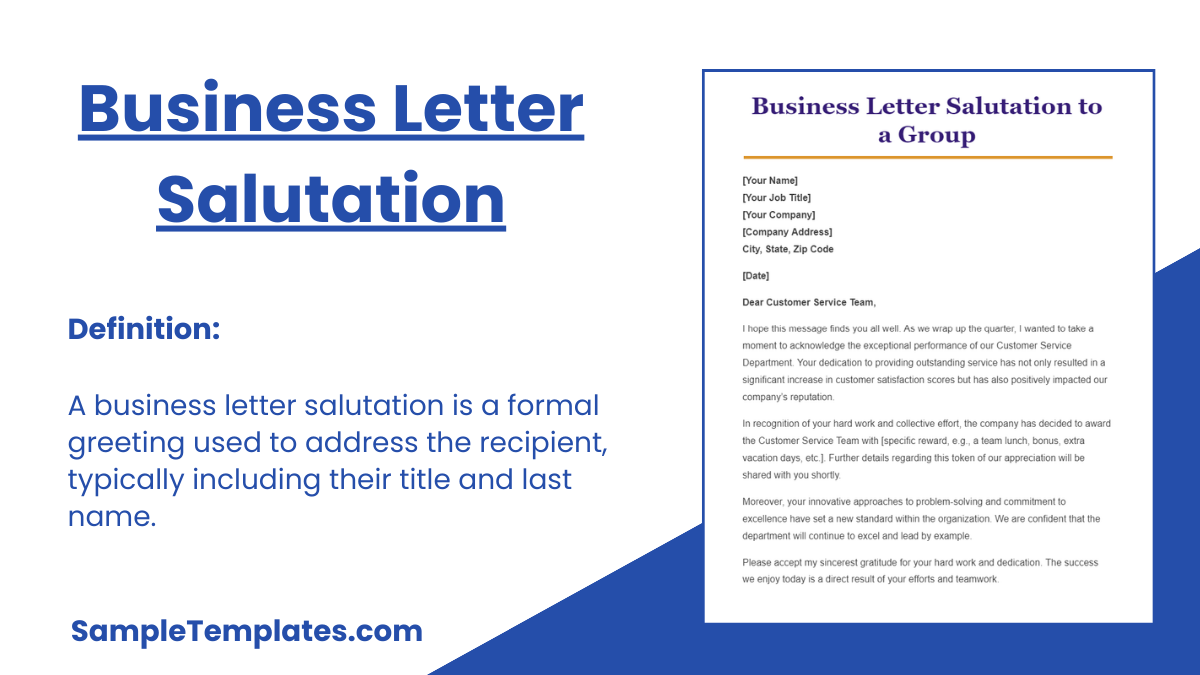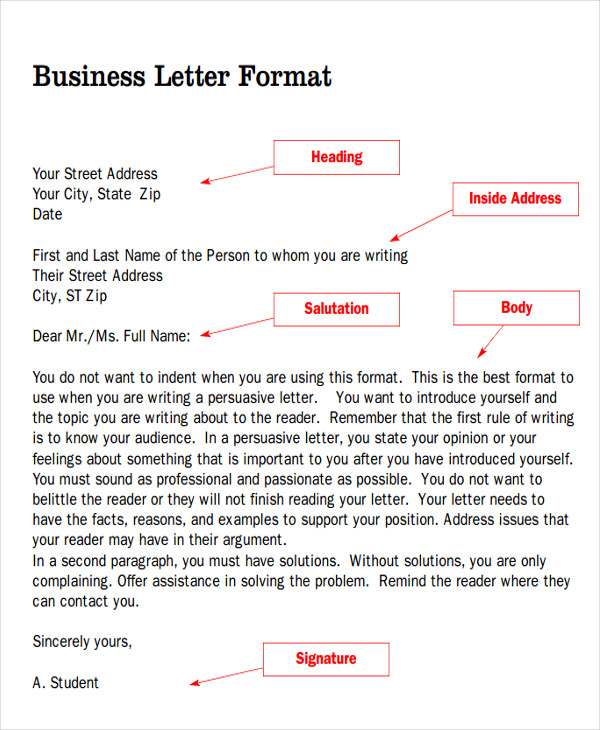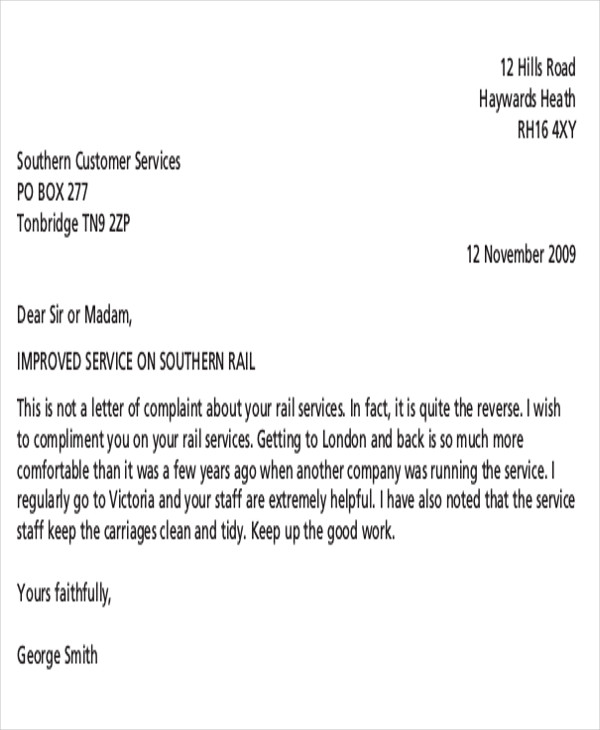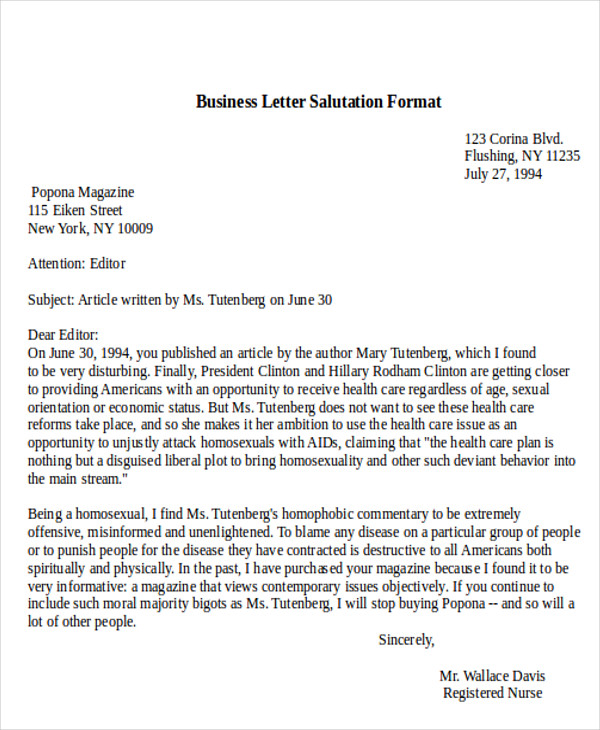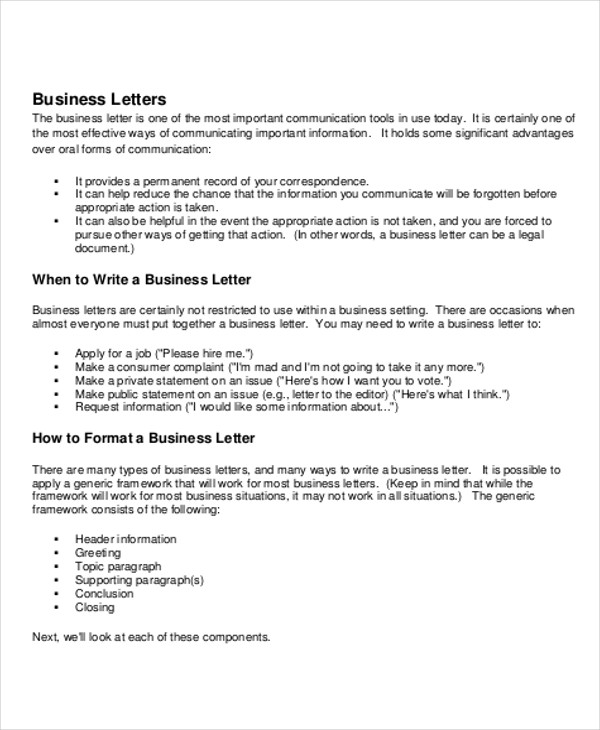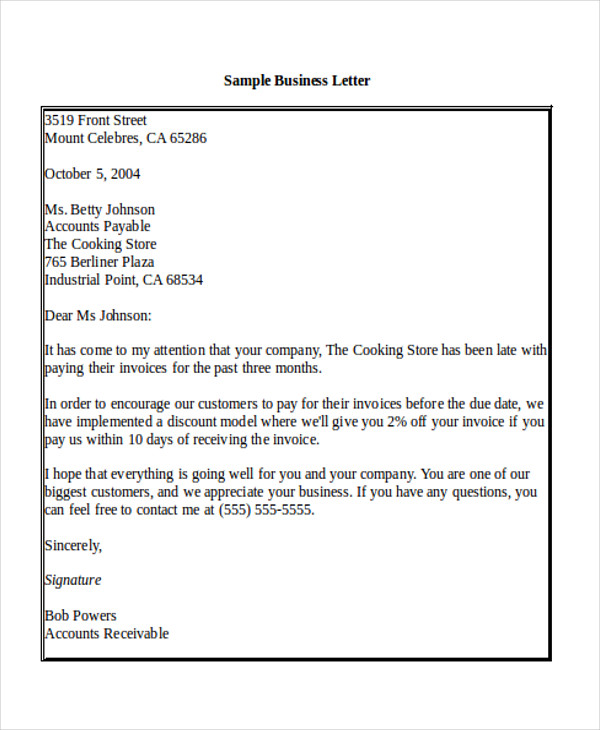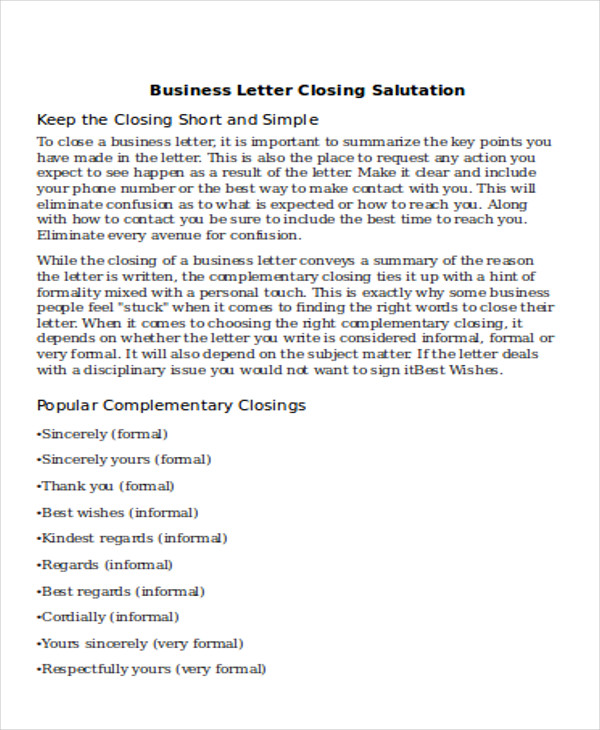There is a concept in psychology called the serial position effect where the first items in a list (the primacy effect) and the last items (the recency effect) are more likely to be recalled because they have both made their way into the long-term memory and remain in the short-term memory, respectively. Applying this concept in business letters, then, would imply that salutations have strong implications in how your readers would feel about you or your company after reading your letter.
Here are some Sample Letters you might want to go over along with some tips on choosing an opening and closing salutation on your business letters.
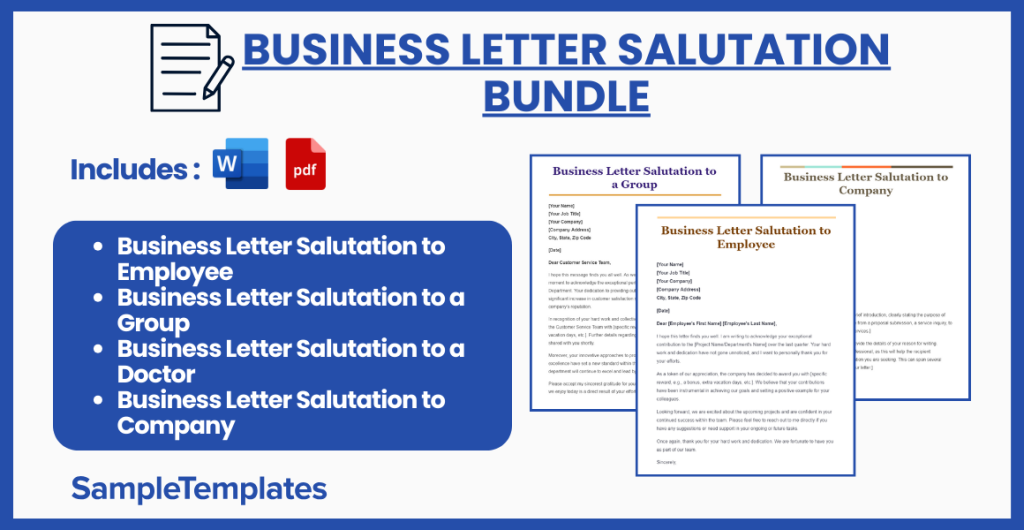
Download Business Letter Salutation Bundle
Business Letter Salutation to Employee
[Your Name]
[Your Job Title]
[Your Company]
[Company Address]
City, State, Zip Code
[Date]
Dear [Employee’s First Name] [Employee’s Last Name],
I hope this letter finds you well. I am writing to acknowledge your exceptional contribution to the [Project Name/Department’s Name] over the last quarter. Your hard work and dedication have not gone unnoticed, and I want to personally thank you for your efforts.
As a token of our appreciation, the company has decided to award you with [specific reward, e.g., a bonus, extra vacation days, etc.]. We believe that your contributions have been instrumental in achieving our goals and setting a positive example for your colleagues.
Looking forward, we are excited about the upcoming projects and are confident in your continued success within the team. Please feel free to reach out to me directly if you have any suggestions or need support in your ongoing or future tasks.
Once again, thank you for your hard work and dedication. We are fortunate to have you as part of our team.
Sincerely,
[Your Signature (if sending a hard copy)]
[Your Name]
[Your Job Title]
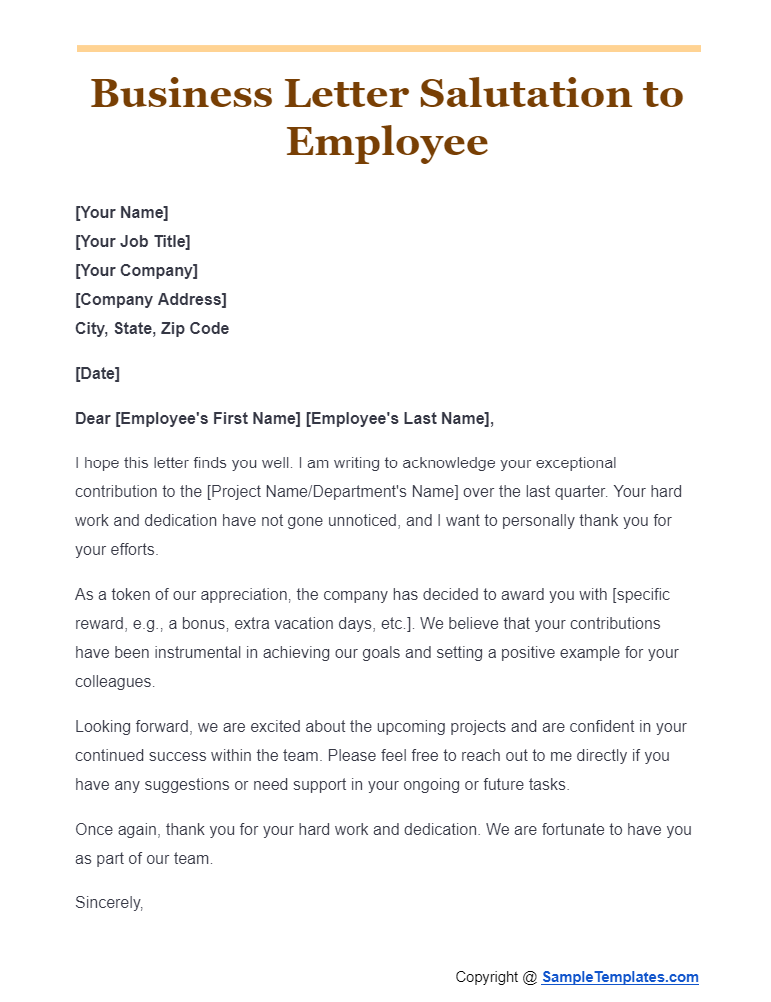
Business Letter Salutation to a Group
[Your Name]
[Your Job Title]
[Your Company]
[Company Address]
City, State, Zip Code
[Date]
Dear Customer Service Team,
I hope this message finds you all well. As we wrap up the quarter, I wanted to take a moment to acknowledge the exceptional performance of our Customer Service Department. Your dedication to providing outstanding service has not only resulted in a significant increase in customer satisfaction scores but has also positively impacted our company’s reputation.
In recognition of your hard work and collective effort, the company has decided to award the Customer Service Team with [specific reward, e.g., a team lunch, bonus, extra vacation days, etc.]. Further details regarding this token of our appreciation will be shared with you shortly.
Moreover, your innovative approaches to problem-solving and commitment to excellence have set a new standard within the organization. We are confident that the department will continue to excel and lead by example.
Please accept my sincerest gratitude for your hard work and dedication. The success we enjoy today is a direct result of your efforts and teamwork.
Looking forward to another quarter of outstanding achievements.
Warm regards,
[Your Signature (if sending a hard copy)]
[Your Name]
[Your Job Title]
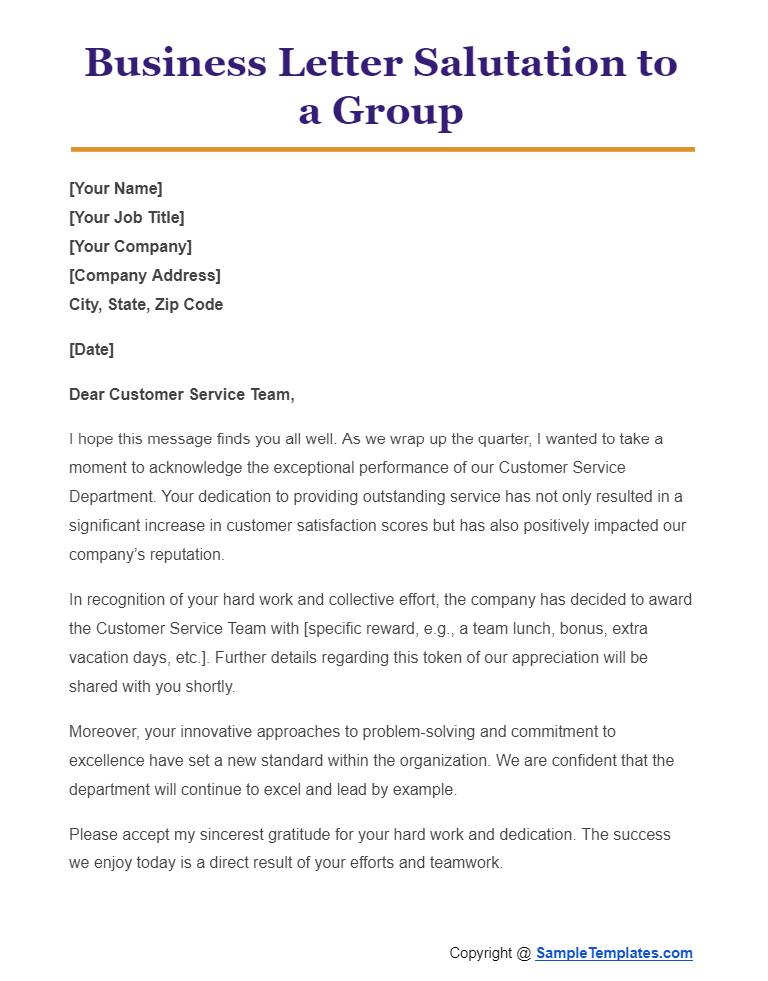
Business Letter Salutation to a Doctor
[Your Name]
[Your Address]
[City, State, Zip Code]
[Email Address]
[Phone Number]
[Date]
Dr. [Doctor’s Last Name]
[Their Title, if applicable, e.g., Director of Research]
[Their Institution or Practice Name]
[Address]
[City, State, Zip Code]
Dear Dr. [Doctor’s Last Name],
[Introduction – Begin your letter with a brief introduction, stating the purpose of your correspondence. For example, you might be writing to inquire about a professional opportunity, to request information, or to discuss a business matter related to their expertise.]
[Body of the Letter – Here, elaborate on the reason for your letter. Provide necessary details to help the recipient understand your request or the information you’re seeking. This section can be several paragraphs long, depending on the complexity of your inquiry or proposal.]
[Conclusion – Wrap up your letter by summarizing your main points or your request. You can also express your appreciation for the recipient’s time and consideration. Indicate any attachments or enclosures.]
Sincerely,
[Your Name]
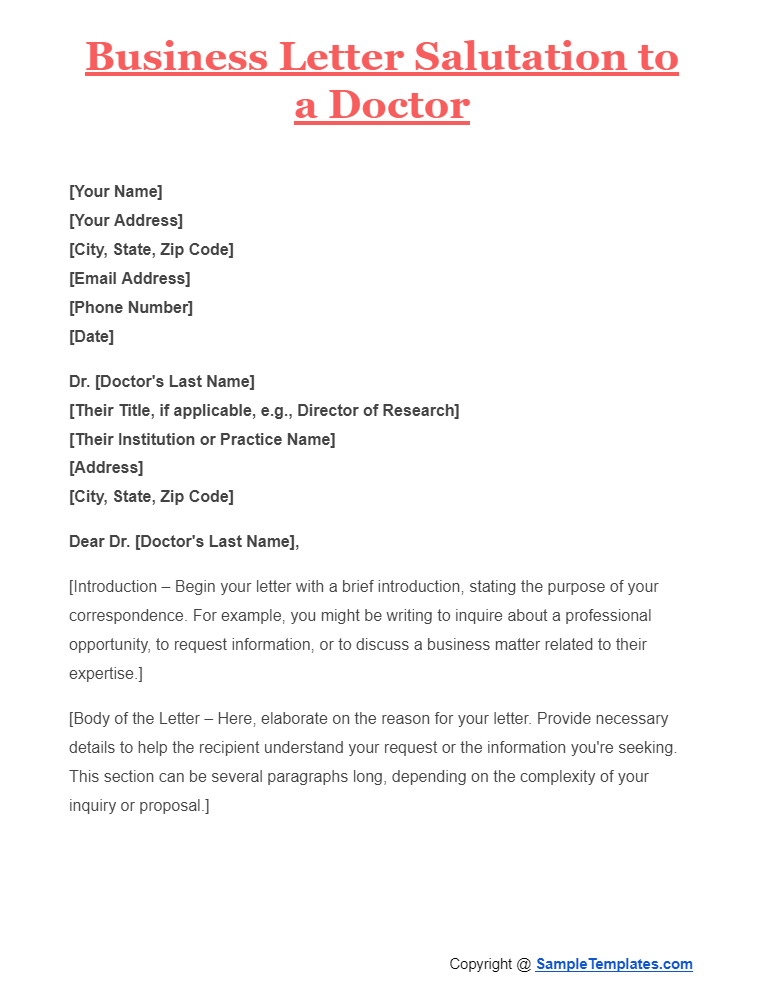
Business Letter Salutation to Company
[Your Name]
[Your Address]
[City, State, Zip Code]
[Email Address]
[Phone Number]
[Date]
[Company Name]
[Department, if applicable]
[Company Address]
[City, State, Zip Code]
Dear [Appropriate Salutation],
[Introduction – Start your letter with a brief introduction, clearly stating the purpose of your correspondence. This could range from a proposal submission, a service inquiry, to feedback regarding their products or services.]
[Body of the Letter – In this section, provide the details of your reason for writing. Ensure you are clear, concise, and professional, as this will help the recipient understand your request or the information you are seeking. This can span several paragraphs based on the content of your letter.]
[Conclusion – Conclude your letter by summarizing the main points or your specific request. Express your thanks for their time and consideration. Mention any attachments or documents you are including with the letter.]
Sincerely,
[Your Name]
[Your Title, if applicable]
[Attachments: if any]
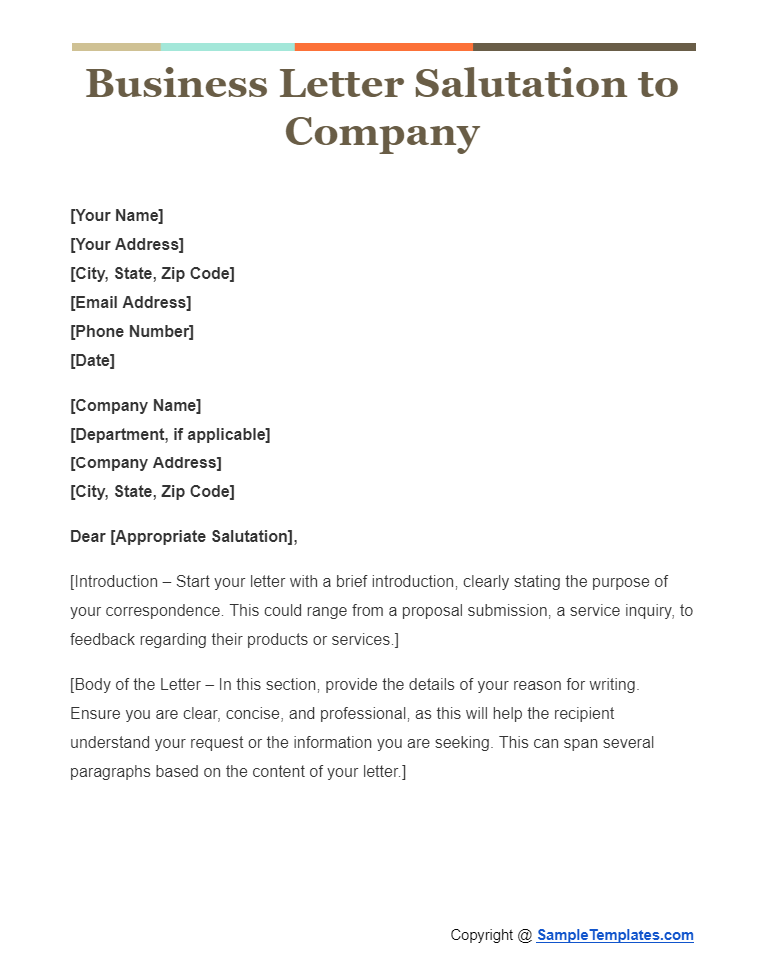
Browse More Templates On Business Letter Salutation
Business Letter Salutation Example
Why is a Business Letter Salutation Important?
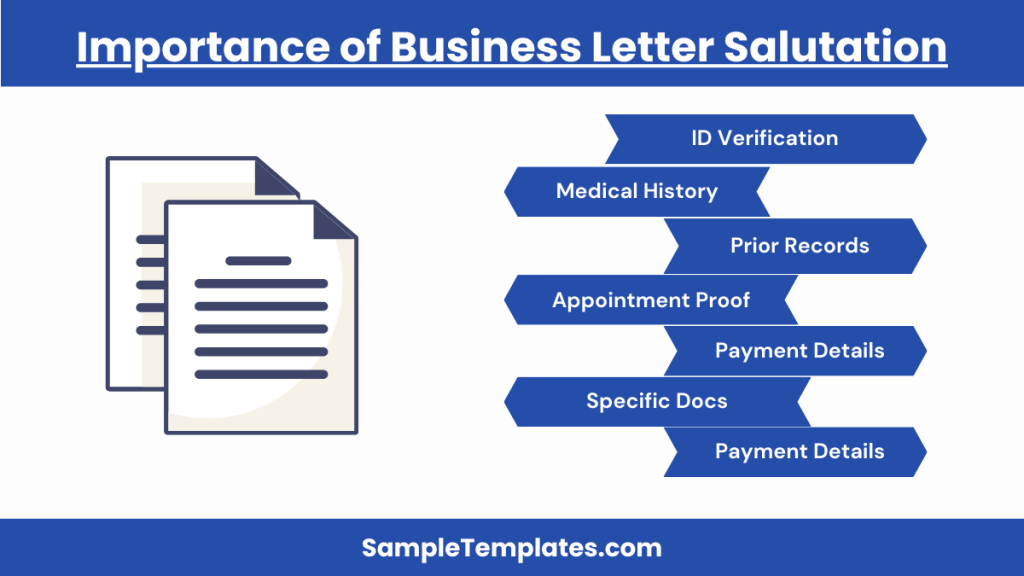
A business letter salutation is important for several reasons, as it sets the tone for the entire communication and plays a key role in establishing the relationship between the sender and the recipient. Here are some specific reasons why the salutation in a business letter is crucial:
- First Impression: The salutation is often the first thing the recipient sees when they open the sample letter. It sets the first impression and can influence how the rest of the message is received. A proper salutation conveys professionalism and respect, which are foundational in any business interaction.
- Tone and Formality: The choice of salutation sets the tone and level of formality for the entire letter. It indicates the nature of the relationship between the parties (formal, semi-formal, or informal) and can subtly influence the recipient’s perception of the message’s importance and urgency.
- Respect and Courtesy: Using an appropriate salutation shows respect and courtesy towards the recipient. It acknowledges their position and the effort you’re willing to put into addressing them properly. This can be especially important in cultures that place a high value on formalities and titles.
- Personalization and Engagement: Personalizing the salutation by using the recipient’s name, when known, can increase engagement and make the recipient more receptive to the message. It demonstrates that the sender has taken the time to tailor the communication, making the recipient feel valued and respected.
- Clarity and Direction: In cases where a formal letter might be addressed to a company or a specific department within a company, a clear salutation can help ensure that the letter reaches the intended recipient or department. This is particularly important in avoiding misunderstandings or delays in communication.
- Professional Standards: Adhering to the conventions of business letter writing, including the use of a proper salutation, reflects adherence to professional standards. It demonstrates that the sender is knowledgeable about business etiquette, which can enhance the sender’s credibility and the perceived reliability of the message.
In essence, the salutation in a business letter is not just a formality but a critical component that enhances communication effectiveness, demonstrates professionalism, and fosters respect and engagement between business entities.
Business Letter Salutation to a Woman
Business Letter Salutation Format
Salutations
Following the definition in the dictionary, salutations are “a standard formula of words used in a letter to address the person being written to.” A standard formula, therefore, means that we traditionally open letters with “Dear” and end them with the rather romantic-sounding “Sincerely Yours.”
While they are standard, there are people who do not feel at all comfortable with greetings such as these in professional letters. “Dear,” to them, sounds too affectionate. Similarly, they find closing with a “Sincerely Yours” to be rather odd to say to someone they don’t know so well and to whom they most definitely do not belong.
Opening Salutations
Opening Personal Business Letters with “Dear” doesn’t seem too bad. In fact, while there are some, not many people would have a lot of trouble with using this as an opening salutation. However, if you are uncomfortable with this, you may also begin with “To” or just drop it totally and write the name of your letter’s recipient.
When addressing the recipient, here are some things you might want to remember:
- A “Mr.” is used for males while a “Ms.” or “Mrs.” is used for females. If you are unsure about a woman’s marital status, just stick with “Ms.” If writing in British English, you don’t have to put punctuation marks while in American English, your salutations would be written with a full stop and a comma or a colon.
- Use their appropriate title. Doctors and those with doctorate degrees should be addressed with a “Dr.” For other professionals, however, you would have to completely spell out their title like “Attorney” or “Honorary.”
- If you know the recipient well, you may use just their first names. If you are unsure about their sex, you may use only their first name. For example: Dear John Cena.
- Only use “To Whom it May Concern” or “Dear Sir/Madame” as a last option. As much as possible, find out to whom the letter should be addressed.
Business Letter Salutation Sample
When Should you use a Business Letter Salutation?
Using a business letter salutation is appropriate and necessary in various circumstances that require formal communication. Here are some scenarios when you should definitely use a business letter salutation:
- Initial Introductions: When you are reaching out to someone for the first time, especially if you have not had any prior interaction, it’s important to use a formal salutation. This helps set a professional tone for the relationship.
- Formal Requests: Whether you are applying for a job, requesting information, or asking for assistance, a business letter salutation is crucial. It shows respect for the recipient and underscores the seriousness of your request.
- Communication with Higher-Ups: When you’re writing to someone higher up in the hierarchy, such as a manager, executive, or company leader, using a formal salutation is a sign of respect and professionalism.
- External Business Correspondence: Any communication with external parties, such as clients, partners, suppliers, or government agencies, should start with a proper salutation. This establishes a professional tone and can help make a positive impression on behalf of your organization.
- Addressing Formal Issues: If you are addressing a complaint, issuing a formal apology, or discussing sensitive matters, a salutation helps to convey the seriousness with which you are approaching the matter.
- Legal and Official Documents: In the context of contracts, sample agreements, legal notices, and other official documents, a formal salutation is often required as part of the standard formatting.
- Cultural Expectations: In many cultures, formalities in business communication are expected, and failing to use a proper salutation can be seen as rude or unprofessional. If you’re communicating across cultures, it’s wise to err on the side of formality.
- When Uncertain: If you’re unsure about the level of formality required in your communication, it’s better to use a formal salutation. Over time, as your relationship with the recipient develops, you may adjust the level of formality based on mutual understanding and context.
Choosing the right salutation involves considering the relationship with the recipient, the communication’s context, and cultural expectations. When in doubt, opting for a more formal salutation is usually the safest approach.
Appropriate Salutation for Business Letter
Tips For Writing Business Letter Salutations
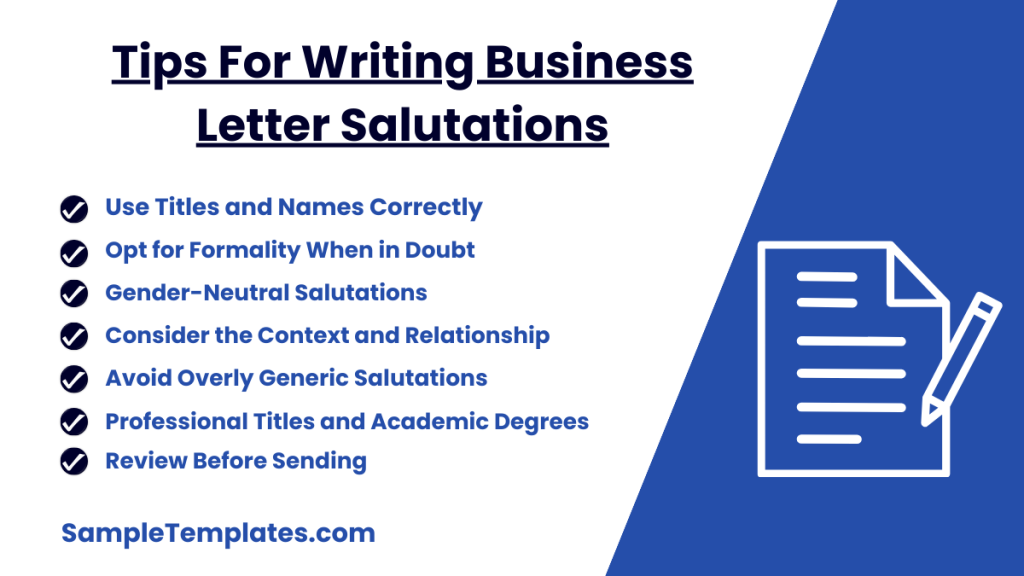
Writing effective business letter salutations is an art that combines respect, professionalism, and attention to detail. Here are some tips to help you craft the perfect salutation for your business letters:
- Know Your Recipient: Whenever possible, try to find out the name of the person you are writing to. Addressing someone by their name, rather than a generic title, adds a personal touch and shows that you have taken the effort to personalize your communication.
- Use Titles and Names Correctly: If you know the recipient’s name, include their title (e.g., Dr., Mr., Ms., Mrs.) unless you’re certain they prefer otherwise. For women, use “Ms.” unless you know they prefer “Mrs.” or “Miss.” Ensure you spell their name correctly—it’s a basic yet crucial aspect of showing respect.
- Opt for Formality When in Doubt: If you’re unsure about the appropriate level of formality, err on the side of caution and choose a formal salutation. “Dear [Title] [Last Name],” works well in most scenarios.
- Gender-Neutral Salutations: In cases where the recipient’s gender is unknown, use their full name without a title or use a gender-neutral salutation like “Dear Jordan Smith” or “Dear [Full Name].”
- Consider the Context and Relationship: The salutation you choose should reflect your relationship with the recipient and the letter’s context. For instance, “Dear Mr. Smith,” is suitable for formal communications, while “Hi Jordan,” might be acceptable for a follow-up email with someone you have previously met.
- Avoid Overly Generic Salutations: While sometimes it might be necessary to use generic salutations (e.g., “Dear Sir/Madam,”), try to avoid them if possible. They can make your letter seem impersonal. If you’re writing to a specific department or role and the individual’s name is not known, a salutation like “Dear Hiring Manager,” or “Dear Customer Service Team,” can be more effective.
- Professional Titles and Academic Degrees: If the recipient holds a professional title or academic degree, it’s respectful to include it in your salutation (e.g., “Dear Professor Smith,” or “Dear Dr. Johnson,”).
- Cultural Sensitivity: Be aware of cultural differences in addressing business letters. Some cultures place great emphasis on titles and hierarchies. When communicating internationally, a little research into the appropriate form of address can go a long way.
- Review Before Sending: Finally, review your salutation before sending the simple letter. A misspelled name or incorrect title can detract from the message you’re trying to convey and can even offend the recipient.
Remember, the goal of a business letter salutation is not just to start a letter but to do so in a way that shows respect and professionalism, setting the stage for positive communication.
Business Letter Closing Salutation
Closing Salutations
When closing your letter, “Sincerely Yours” would be typically used. But if you this creeps you out, you may also consider using the following:
- With kind regards,
- Sincerely,
- Best wishes, or
- Thanks.
Another way to close letters would be by stating who you are such as “Your Client” or simply signing your name. See our other Formal Letter Examples to get more ideas on composing professional-sounding letters.
What is a generic salutation?
A generic salutation is a non-specific greeting used when the recipient’s name or gender is unknown, such as “Dear Sir or Madam,” or “To Whom It May Concern.”
What is the proper salutation for a business letter?
The proper salutation for a business letter typically includes a courtesy title and the recipient’s last name, such as “Dear Mr. Smith,” or “Dear Ms. Jones.”
Which is the most professional opening salutation?
The most professional opening salutation in a business letter is “Dear [Title] [Last Name],” because it respectfully acknowledges the recipient’s professional status and identity.
How do you address a business letter to an unknown recipient?
When addressing a business letter to an unknown recipient, use a generic but respectful salutation like “Dear Hiring Manager,” or “To Whom It May Concern,” to maintain formality.
What is a salutation in business?
A salutation in business is the greeting at the beginning of a letter or email, which typically addresses the recipient with a specific title and surname, setting a formal tone for the communication.
In conclusion, selecting an appropriate salutation is crucial in business correspondence. Personalization, correctness, and sensitivity to cultural nuances enhance professionalism. Choose wisely based on the recipient’s identity, relationship, and context to ensure effective communication.
Related Posts
Company Introduction Letter Samples & Templates
Resignation Letter for Medical Samples & Templates
Letter of Intent Samples & Templates
Letter of Intent for a Job Samples & Templates
Lease Proposal Letter Samples & Templates
Letter of Inquiry Samples & Templates
Character Reference Letter Samples & Templates
Claims Letter Samples & Templates
Response Letter Sample & Templates
Follow Up Letter Samples & Templates
Sample Project Proposal Letter Templates
Donation Letter Samples & Templates
Addressing a Formal Letter Samples & Templates
Grievance Letter Samples & Templates
Sample Sponsor Thank You Letter Templates
